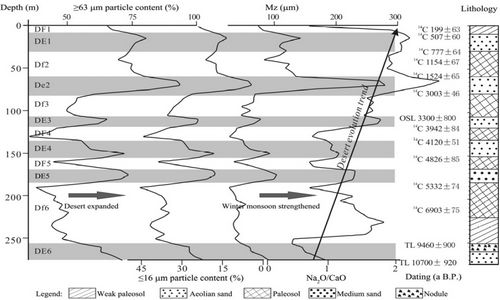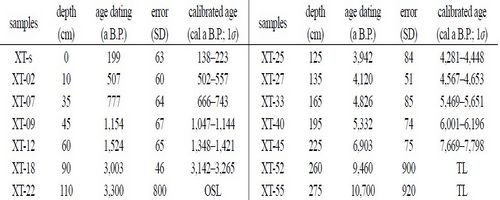Millennial-scale evolution of Hunshandake Desert and climate change during the Holocene in Inner Mongolia, northern China
Updatetime:2011-01-10From:
【Enlarge】【Reduce】
The Hunshandake Desert is located at the northern edge of the East Asian monsoon region, and its natural environment is sensitive to monsoonal changes. Geologic records suggest that desert evolution corresponding to climate change had experienced several cycles in the Holocene, and the evolutionary process can be distinguished by four dominant stages according to changing trends of the environment and climate. (1) Holocene Ameliorative Period (11.0–8.7 cal ka B.P.), when the desert area gradually shrank fol-lowing an approaching warm-wet climate and strengthening summer monsoon. (2) Holocene Optimum (8.7–6.0 cal ka B.P.), when the majority of moving sand dunes were stabilized and vegetation coverage quickly expanded in a suitable warm-wet cli-mate and a strong summer monsoon. (3) Holocene Multivariate Period (6.0–3.5 cal ka B.P.), during a low-amplitude desert trans-formed between moving and stabilized types under alternating functions of cold-dry with warm-wet climate, and winter monsoon with summer monsoon. (4) Holocene Decay Period (since 3.5 cal ka B.P.), when the desert area tended to expand along with a weakened summer monsoon and a dry climate.
Climate change in the Hunshandake Desert has a high correlation with East Asian monsoon variation and global climate change. Regional warm-humid climate periods usu-ally occur in East Asian monsoon season, and the cold-arid climate periods correspond to the North Atlantic Cold Events. There are remarkable effects of solar radiation and polar ice-cover change on regional climate change. Regional climate change directly affects desert evolution. Regional climate change and evolution of the Hunshandake Desert during the Holocene in Inner Mongolia of northern China can be distinguished by four dominant stages: the early Holocene, when climate became warm, atmospheric humid-ity increased by degrees, and desert area slowly decreased; the maximum Holocene, when climate was warm and hu-mid, shifting sands were mostly stabilized, and the desert area was the smallest; the middle Holocene, when climate changed frequently, and desert expanded or shrank repeat-edly; the later Holocene, when climate was progressively drying, and the desert area extended continuously.
|
Vertical curves of proxy’s variation showing Hunshandake Desert evolution in the Holocene (Picture/Sciences in Cold and Arid Regions) |
|
Age dating results and their calibrated values by Calib5.0 (Picture/Sciences in Cold and Arid Regions) |
Appendix






